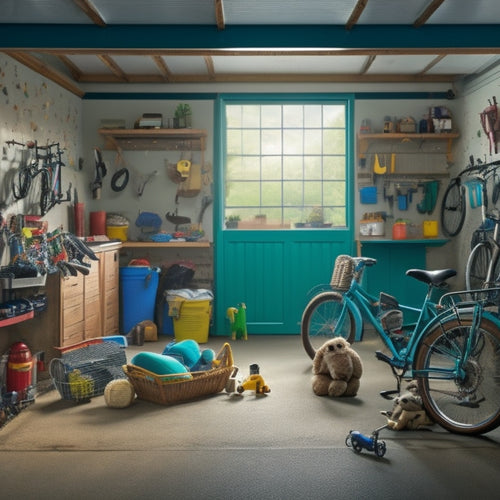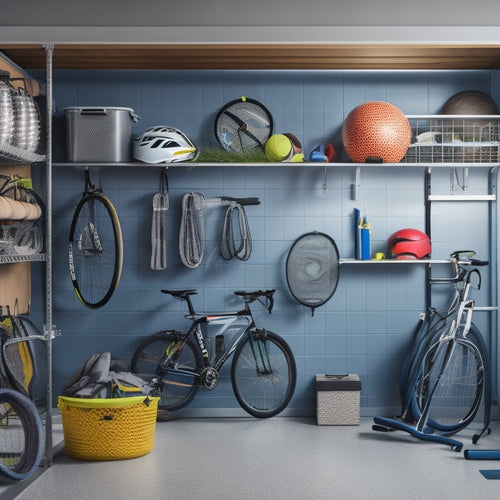
Why Home Gyms in Garages Need Smart Storage
Share
You've invested in a home gym in your garage, but without smart storage, your workouts are easily derailed by clutter, waste time searching for equipment, and risk damage to your gear. Cluttered spaces hinder your workout routines, making it difficult to focus and stay motivated. Inefficient use of garage space can leave you with a cramped exercise area. Plus, you risk safety concerns for family members and deterioration of your expensive gym equipment. You're also wasting time searching for what you need. By implementing smart storage solutions, you can overcome these obstacles and create an efficient, effective, and safe workout space that helps you reach your fitness goals - and that's just the beginning.
Key Takeaways
• Cluttered garage gyms hinder workout routines, waste time, and create safety concerns, making smart storage solutions essential for optimization.
• Inefficient use of garage space can limit exercise areas, but smart storage solutions like wall-mounted racks and shelves can maximize space.
• Deterioration of expensive gym equipment due to moisture and pests can be prevented with smart storage solutions that keep equipment organized and protected.
• Difficulty in finding equipment in cluttered spaces affects workout efficiency, and smart storage solutions with labeling and categorization can solve this issue.
• Smart storage solutions save time and energy by keeping the gym tidy and functional, allowing individuals to focus on their workout routines.
Cluttered Spaces Hinder Workout Routines
Frequently, cluttered garage spaces hinder your workout routines, making it challenging to focus on your fitness goals. A disorganized environment not only wastes your time but also dampens your motivation.
To optimize your workout efficiency, implementing effective storage solutions and organization tips is crucial.
Start by categorizing your equipment and grouping similar items together. This will help you identify what you need to access frequently and what can be stored away. Utilize wall-mounted racks, bins, and baskets to maximize your space and keep your floor clear. Label each storage unit so you can easily find what you need.
Inefficient Use of Garage Space
When you're setting up a home gym in your garage, you're probably excited to start working out. However, you mightn't be using the space as efficiently as you could be.
You're likely wasting floor space with clutter, overwhelming the area with equipment, and disrupting your workout flow with disorganization.
Cluttered Floor Space Wastes
Cramming your garage floor with clutter not only makes it difficult to navigate but also sacrifices valuable space that could be dedicated to your home gym. You're not alone in this struggle; many homeowners underestimate the importance of smart storage solutions in their garage. As a result, cluttered floor space becomes a significant waste of potential exercise area.
To optimize your garage space, you need to rethink your storage strategy. Start by identifying the items that can be stored off the floor, such as bikes, tools, and seasonal decorations.
Invest in wall-mounted racks, shelves, and cabinets that can keep these items organized and out of the way. This will create a more open floor plan, allowing you to better utilize the space for your home gym.
Equipment Overwhelms Garage Area
About half of your garage space is consumed by exercise equipment, leaving you with a cluttered and chaotic area that's not conducive to a productive workout. You're not alone in this struggle. Many home gym enthusiasts face the same challenge: how to maximize storage and create an organized workout space. The good news is that there are effective organization solutions to help you reclaim your garage and create a functional home gym.
Here are some key considerations to keep in mind:
-
Assess your equipment: Take stock of the machines, free weights, and accessories you use regularly. This will help you determine the most efficient storage solutions.
-
Opt for vertical storage: Install shelves, hooks, or racks to store equipment like bikes, dumbbells, and resistance bands, keeping them off the floor and out of the way.
-
Utilize corner space: Make the most of often-wasted corner areas with custom storage units or carousels.
-
Choose multi-functional equipment: Invest in machines that serve multiple purposes, reducing the overall amount of equipment taking up space.
-
Designate a workout zone: Create a dedicated area for your workouts, keeping the rest of the garage organized and clutter-free.
Disorganization Hampers Workout Flow
Cluttered garage spaces disrupt your workout flow, making it difficult to focus on your fitness goals as you navigate through a maze of equipment and accessories. You know you're not getting the most out of your home gym when you're wasting time searching for misplaced gear or tripping over clutter.
Inefficient use of garage space not only hinders your productivity but also creates a stressful environment that can discourage you from working out altogether. To maximize space and optimize your workout experience, prioritizing organizing your equipment is crucial.
Start by categorizing your gear into groups, such as cardio, strength training, and accessories. Assign a designated spot for each category, ensuring that frequently used items are easily accessible. Consider investing in storage solutions like shelves, hooks, or bins to keep your equipment off the floor and out of the way.
Safety Concerns for Family Members
As you set up your home gym in the garage, you'll want to contemplate the safety of your family members.
You'll need to identify potential slip and fall hazards, such as wet floors or uneven surfaces, and take steps to mitigate them.
Additionally, you'll need to ponder the risks associated with heavy equipment and figure out how to safely secure it to prevent accidents.
Slip and Fall Hazards
When you're setting up a home gym in your garage, you'll need to clear the floor of slippery substances and obstacles to prevent family members from taking a tumble. Slip and fall hazards are a significant concern, especially in a garage where the floor can be uneven, oily, or cluttered.
You'll want to take safety precautions to make sure everyone can move around safely. To prevent injuries, make sure to:
- Clean up oil spills and other slippery substances immediately
- Remove any obstacles like tools, toys, or equipment from the floor
- Install non-slip mats or coatings on the floor to provide traction
- Keep the floor clear of clutter and tripping hazards like cords or wires
- Ensure good lighting in the garage to help family members see any potential hazards
Heavy Equipment Risks
Heavy machinery like treadmills, free weights, and exercise machines can pose significant risks to family members, especially children and pets, if not properly secured or stored. These machines can be hazardous, and it's essential to take measures to prevent accidents.
| Hazards | Outcomes |
|---|---|
| Crushing injuries | Permanent disability or even death |
| Electrical shock | Severe burns or cardiac arrest |
| Falling equipment | Head trauma or broken bones |
You must make sure that your equipment is well-maintained and stored in a way that prevents it from tipping over or falling. Regular equipment maintenance and space optimization can help reduce the risk of accidents. For example, anchoring heavy equipment to the floor or wall can prevent it from shifting or toppling over. Additionally, storing smaller equipment and accessories in designated bins or shelves can keep them out of reach of children and pets. By taking these precautions, you can create a safe and functional home gym in your garage.
Deterioration of Expensive Gym Equipment
You invest a significant amount of money in your gym equipment, so it's frustrating to see it deteriorate prematurely due to poor storage conditions. When you don't prioritize equipment maintenance, you're not only wasting your investment but also compromising your workout efficiency.
Here are some common issues that arise from inadequate storage:
-
Moisture buildup: Humidity in your garage can cause rust or corrosion on metal equipment, reducing its lifespan.
-
Dust accumulation: Failing to cover or store equipment properly allows dust to settle, which can affect its performance and require frequent cleaning.
-
Cable damage: Improperly stored cables can become tangled, frayed, or even damaged, leading to equipment malfunction.
-
Pest infestation: Rodents or insects can damage equipment or its components, causing costly repairs or replacements.
-
Equipment misplacement: Inadequate storage solutions can lead to equipment being misplaced or lost, disrupting your workout routine.
Difficulty in Finding What You Need
Cluttered and disorganized garage gyms can make it impossible to quickly find the equipment you need, wasting valuable workout time. You know the feeling - you're pumped up and ready to crush your workout, but you can't find that one dumbbell or resistance band you need.
You're left digging through a mess of cables, mats, and miscellaneous gear, getting frustrated and losing momentum. This is where smart storage solutions come in. By implementing effective organization tips, you can keep your garage gym tidy and functional.
Install shelving units or cabinets to store smaller items like weights, accessories, and cleaning supplies. Use hooks to hang resistance bands, jump ropes, or other equipment that's easy to misplace. Labeling each storage bin or shelf can also help you quickly identify where everything is, saving you time and energy.
Aesthetics Matter for Home Gyms
Beyond functionality, a well-designed garage gym should also consider aesthetics to create a motivating and inviting space that inspires you to work out regularly. You want to look forward to spending time in your gym, and a visually appealing environment can make all the difference.
When it comes to designing your garage gym, don't neglect the importance of aesthetics.
Here are some design inspiration and organization tips to get you started:
-
Choose a cohesive color scheme: Select a few colors that motivate and energize you, and use them consistently throughout your gym.
-
Add some greenery: Plants can purify the air and create a calming atmosphere, perfect for a post-workout stretch.
-
Incorporate mirrors: Mirrors can create the illusion of a larger space and provide a convenient way to check your form.
-
Use lighting to set the mood: Bright lights can energize, while softer lights can create a relaxing ambiance.
-
Display your goals: Hang up motivational quotes, fitness milestones, or progress photos to keep you driven and focused.
Frequently Asked Questions
What Is the Ideal Temperature for Storing Gym Equipment in a Garage?
You want to store your gym equipment in a garage at an ideal temperature between 60°F and 70°F to guarantee equipment longevity, as extreme temperatures can cause material degradation and affect performance over time.
Can I Use Pegboards for Storing Small Gym Accessories?
You're clever to contemplate pegboards for storing small gym accessories, and you'll be thrilled to know they're a fantastic choice, offering easy access and visibility, while keeping your garage organization on point and clutter-free.
How Often Should I Clean My Garage Gym Equipment?
You should clean your garage gym equipment every 1-2 weeks to maintain its performance and prevent damage. Regular cleaning prevents corrosion, maintains smooth operation, and keeps your gear in top condition, regardless of storage temperature.
Are There Any DIY Storage Solutions for Garage Gyms?
You can create DIY storage solutions for your garage gym by installing wall shelving for weights and accessories, and utilizing ceiling hooks to hang equipment like bikes or kettlebells, keeping your space organized and clutter-free.
Can I Store Gym Equipment in a Garage With High Humidity?
'Did you know 60% of gym equipment damage is caused by humidity? You can store gym equipment in a humid garage, but you'll need to use a dehumidifier and guarantee proper ventilation to prevent rust, making regular equipment maintenance a must.'
Related Posts
-

Why Can't You Fit Everything in Your Garage?
You've invested in a garage, expecting ample space to store your belongings, but somehow, it still feels like a cramp...
-

7 Best Garage Storage Solutions for Athletes
As an athlete, you know the struggle of cluttered garages and lost gear. To maximize your space, start by categorizin...

